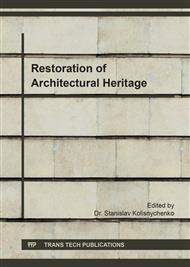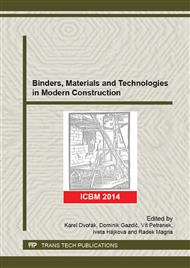p.11
p.17
p.21
p.25
p.30
p.36
p.44
p.50
p.56
The Utilization of Waste Aluminosilicate to Prepare Cement Composite with Thermal Insulating and Drying Effect
Abstract:
Increasing energy prices, along with escalating demands for thermal insulation properties of enclosure structures, force the owners of buildings to reduce the operating costs of heating. That is why the question of reducing the energy consumption of buildings, also including the category of historical buildings [10], has been gaining ground. The reduction of energy consumption of these buildings is often accompanied by the requirement to eliminate moisture problems of base structures caused by leaking or broken waterproofing of the bottom part of the object. The subsequent increase of the thermal resistance of the building envelope must be performed by means of special insulation materials allowing the drainage of liquid water from the structure. The paper presents the properties and the influence of the developed materials on the course of built-in moisture in the base structure affected by this phenomenon using Delphin simulation software, based on the measured thermal and technical parameters. The developed material is a composition of pozzolan binder, foaming agent and waste resulting from the production of cellular concrete blocks. According to tests carried out in [1], it is possible to produce concretes with sufficient strengths for rehabilitation boards when you substitute natural aggregates with waste aluminosilicate and, according to [2, 3, 4, 5, 6], you will achieve better rehabilitation and thermal insulation properties by using porous filler. The developed material is intended for the so-called soft rehabilitation, and its function is specifically presented on a structure built from sandstone blocks. This type of structures can be found in north Bohemia and the application of rehabilitation work must be very carefully considered, because quick drying of built-in moisture in masonry, for instance by means of cutting the lower part of the structure and by inserting waterproofing, will cause shape changes of the structure accompanied by the formation of cracks.
Info:
Periodical:
Pages:
30-35
Citation:
Online since:
April 2015
Price:
Сopyright:
© 2015 Trans Tech Publications Ltd. All Rights Reserved
Share:
Citation:



